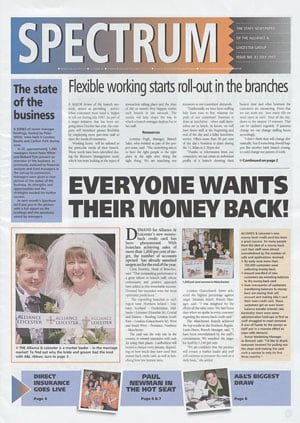
In a social world, businesses are social organisations. Within any organisation, there is a maze of pathways along which communications travel. Imagine the endless conversations, meetings, letters, memos, electronic transmissions and receipts of messages between people each day. For example, during a typical morning in a busy office you might expect to:
- Write a letter in response to a customer enquiry
- Receive 3 telephone calls, one of which requires you to phone back after consulting your line manager to clarify some details
- Check your electronic mailbox for e-mails
- Attend a departmental meeting
- Discuss the new holiday arrangements with colleagues over morning coffee
- Read the latest team brief for staff
- Write and send an urgent message to another office by fax
- Talk face-to-face to two clients.
Most of the morning will, in fact, have been spent communicating with other people. In every organisation, employees spend a large proportion of every working day communicating. It is estimated that people working in offices spend as much as two thirds of each working day communicating in one form or another.
Effective communication
Effective communications are, therefore, vital to any business or organisation. They are a foundation stone upon which its activities and functions depend. Communications provide an essential link between employees of an organisation and its customers, between employees and other employees, between employees and employers as well as between an organisation and all of the stakeholders involved with the business either formally or informally. Although the structure and effectiveness of any organisation is almost entirely influenced by the way it communicates, it is very easy to take communications for granted.
On 21st April 1997, the Alliance and Leicester changed from being a mutual building society to a public limited company, listed on the London Stock Exchange. This study not only provides an audit of Alliance and Leicester’s many different communication systems, but also provides a comprehensive analysis of the nature and purpose of communications and illustrates how the process of communication within a large organisational structure can be developed to build a better and more successful business.
The Alliance & Leicester is a major financial services group dedicated to the provision of a range of personal financial products for customers. Its objective is to provide customers with a comprehensive range of mortgage, investment and insurance products, cash transmission services and commercial banking facilities that are high in quality and competitive in price. The Alliance & Leicester has more than five million customers living in the UK, plus many expatriates throughout the world.
Alliance & Leicester’s broad range of financial products has been designed to meet the needs of customers throughout their lives, from cash card accounts to investment accounts, insurance and pension products. Products are available through a wide range of distribution channels. For example, Girobank, acquired by the Alliance & Leicester in 1990, was the first telephone bank in the UK. Today, more Alliance & Leicester customers are able to use a full 24-hour telephone and postal banking facility than with any other bank or building society in the UK. Products and services are also available through Alliance & Leicester’s branch network and through the 8,800 ATM machines in the LINK network, by post or at almost 20,000 post offices. This range of access points means that Alliance & Leicester uses a wide network of communication whenever and wherever it best suits the needs of customers.
The process of communication

Communication is a two-way process of passing on and receiving ideas and information. For example, communication might result in a high degree of understanding between the sender and receiver of a message which goes beyond factual data to include the sharing of ideas, beliefs and opinions.
The process of communication involves a transmitter (or sender) sending messages to receivers. A transmitter should put information into a form which receivers can understand – this might include oral, written, visual or electronic messages. The transmitter chooses a suitable medium to send messages to the receiver such as letter, fax or phone call. Within the Alliance & Leicester, efficient communication provides employees with information which assists their work. Informing employees about developments within the business helps to involve them further and create an understanding of how these developments may affect their daily decisions.
Communications are not only used by senior managers for giving instructions downwards, but also for passing on business strategy so that more people within the Company understand how the Alliance & Leicester is working towards its objectives. The communication process works equally the opposite way, from lower to higher levels, with open management in a team orientated workplace where employees and their ideas are listened to. Internal communications within Alliance & Leicester also provide a mechanism for discussion and negotiation. Good internal communication enables employees to discuss issues within the workplace. The Team Brief is also frequently used to keep employees informed of research upon important issues and subsequent proposals.
Various communication methods are used by Alliance & Leicester to motivate employees and improve teamwork. Team Meetings, for example, bring employees together to focus upon certain issues. Informing employees about what is happening within the company helps them feel involved and improves their commitment.
Written communication

Written communications vary from the very simple to the very complex. At the Alliance & Leicester written communication is particularly useful when:
- The information needs to be received by many people in different places
- The information is complex and requires extensive study
- The information needs to be referred to over a period of time.
Written communications include:
- Spectrum – This is a staff newspaper which is distributed to all staff and pensioners. It is a particularly useful way of keeping a large number of people informed of both business and social matters. For example, the paper provides up-to-date coverage of sports events, an Insight column upon events in the financial services industry and an ‘Over To You’ forum for the views of staff.
- Team Brief – This is a monthly production which contains business news from the whole of the Alliance & Leicester. It is used by managers to brief staff on developments throughout the business. Staff Suggestion Scheme – This was created to encourage and reward staff for suggestions. It was introduced to improve customer service and to help streamline procedures.
- Bulletin – Knowledge of product changes and promotional activity is particularly important for staff employed by the Alliance & Leicester. The Bulletin is produced by the Company’s Marketing Department to update staff on promotional activity.
- Sales Talk – This is a quarterly production for the Girobank sales force providing updates on their own business areas and those of their competitors.
- Office Instructions – These are paper based instructions, sent to individual branches, used for updating staff on new product launches and procedural changes.
- Office Communications – These are for branches but usually transmit general messages.
- One Offs – From time to time, one off communications are produced to update staff or to emphasise important procedures.
Electronic communications
Over recent years, there have been many different developments in electronic technology which have affected all staff at the Alliance & Leicester in one way or another. Initially, the Alliance & Leicester, like all other businesses, was dependent on the telephone for internal and external communication. However, with constant advances taking place in communication technology, the Alliance & Leicester has now invested in new methods of communication which help develop efficiency advantages over its rivals. Electronic communications include:
- E-mail – Computer stations within the Alliance & Leicester are equipped for email.
- Internet – A mortgages web-site has been in existence for over a year with personal banking and investments to be added to this in the near future.
- Fax system – Alliance & Leicester uses a facility to distribute multiple faxes simultaneously to over 1,000 fax machines within the Company. These are usually major announcements affecting the whole of Alliance & Leicester when it is important for staff to receive information as quickly as possible. Individual faxes can also be sent to specific areas within the company.
- Computer system – Messages can be transmitted to branches nation-wide via Alliance & Leicester’s administration centre in Leicester. A prompt is received on each computer screen in the branch allowing messages to be called up. This system has been used for rate changes, important announcements and security messages.
Oral communication

Oral communication involves the transmission of information effectively by word of mouth. For many people at the Alliance & Leicester, verbal communication tends to be face-to-face messages, personal discussion and the provision of instruction and guidance. However, oral communication within the Alliance & Leicester also includes:
- Staff training sessions – A one hour training session held each week in the branches between 9.00 am and 10.00 am. They are either prepared by branch staff or are presented in a pre-prepared format.
- Internal conferences
These are held throughout the Alliance & Leicester Group on a regular basis. They include:
- Group Chief Executive’s Briefings for senior managers throughout the country. The Group Chief
- Executive talks to over 1000 of the most senior managers twice a year and answers their questions.
- National Sales Conference held every year for managers in the retail distribution network to discuss performance and future developments.
- Girobank MD’s roadshow – The managing director of Girobank holds roadshows throughout the country for all Girobank staff.
- Girobank Senior Managers briefing for all senior managers.
- Team meetings – Throughout the organisation, managers hold regular meetings with their staff to discuss a range of matters face-to-face.
- Videos – These are used by Alliance & Leicester for training purposes, product launches and for providing messages to staff. Alliance & Leicester also use interactive video.
- Audio tapes – These have been used by Alliance & Leicester for training purposes.
- Tannoy messaging – A tannoy messaging system is used at 2 administration centres to brief staff of important announcements.
Price sensitive information
Since becoming a public limited company, Alliance & Leicester has briefed staff about the management of price sensitive information, particularly at important times for the Company. Price sensitive information is any information about a quoted company which, if it was in the public domain, would be likely to move the share price either up or down.
Price sensitive information is not simply financial performance data. For example, the acquisition and sale of part of the business, the appointment of a senior manager, or a disaster of some kind, could all potentially affect share price. Anyone in possession of price sensitive information which is not yet published is deemed to be an ‘insider.’
External communication
The Alliance & Leicester has a public face or image. This conveys a message which affects or influences everyone who has dealings with the organisation. These include customers such as account holders and mortgagees, suppliers, competitors, the government, communities and agencies.
As a newly listed public company – around 67th in the FT-SE 100 – external communications are particularly important for the Alliance & Leicester as they influence how the organisation is viewed by others. External communications encompass all of the actions of the organisation as well as communications from it. Providing a positive image and reinforcing this through external communication helps to create a more positive working environment for the Alliance & Leicester. This enables it to gain a competitive advantage.
Written communications
The Alliance & Leicester provides a range of information for different stakeholder groups. In addition to business letters sent to personal customers, written communications include:
- Press releases – These include information provided for the press relating to new products, interest rate changes or major business news. They are distributed by fax or post.
- RNS – Stock Exchange announcements.
- Advertorials – Nearly all forms of advertising by the Alliance & Leicester are based on written communication.
- Point of sale literature – Promotional literature is on display in branches and post offices.
- Branch posters – These are discrete ways of communicating a message.
- Mail shots – These are included with monthly statements or may be mailed individually.
- Statement messaging – This involves including important messages for customers on monthly statements.
2-way communications with customers
Using feedback from customers is becoming increasingly important for Alliance & Leicester as the industry becomes more competitive. Opportunities for 2-way communication exist through:
- Group Customer Relations – Customer complaints are a valuable source of information used to improve products and services wherever possible.
- Customer Relations provides a listening ear for customers who are unable to resolve problems with branches or administration centres. It communicates this feedback to senior management and also works with the Ombudsman and other regulatory bodies, to resolve customer issues which have been passed to them.
- A Customer Care Leaflet – Alliance & Leicester believe that customers have a wealth of information about services which could be used both for their benefit and for the organisation as a whole. This freely available leaflet allows customers to communicate their comments and suggestions to the Company.
Oral communication
This type of communication is particularly important for a range of issues affecting the various Alliance & Leicester stakeholder groups. These include:
- Alliance & Leicester Giro/Alliance Account – This provides 24 hour telephone and postal banking.
- Annual General Meeting – The Board of Directors hosts the meeting and answers shareholders’ questions after the business of the meeting is completed.
- Press Conferences – These are generally held to announce important business news such as the announcement by the Alliance & Leicester to convert to a Public Company.
- Analysts briefings – Alliance & Leicester holds formal briefings to inform analysts of its financial performance twice a year.
Government relations
Good communication between businesses and the government is vital to the efficient operation of both. Without regular and established communication channels between the two, bad decisions and policymaking could result from either side. Thus the Alliance & Leicester keeps government members and their advisory teams up-to-date with the Company’s views and intentions. Oral and written correspondence and regular meetings help the Alliance & Leicester meet the challenges of the complex and competitive world of financial services while helping the government.

The pattern and style of communication reflects the values and culture of the whole organisation. Alliance & Leicester employees recently received an Audit Questionnaire which asked them to comment upon communications within the Group. The aim was to allow employees to shape the dialogue between themselves and colleagues across the whole Company. Alliance & Leicester invests heavily in improving communication procedures. Recently the Company has developed:
- Customer First – This is an action programme designed to bring the Company even closer to its customers. The aim is to improve customer communications by building upon Quality initiatives.
- The Branch of the Future – Alliance & Leicester has designed a revolutionary prototype of tomorrow’s branch representing new concepts for customer service.
The type and nature of communications constantly change. No single pattern will continue to be superior to another. By occupying a central place within the Alliance & Leicester’s business strategy, its communication systems help to ensure that the Company continues to develop its business at the forefront of the financial services industry.



